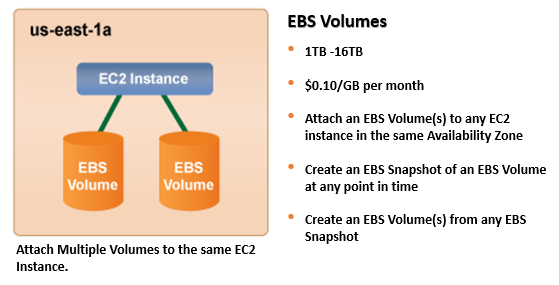AWS Getting Started - AWS EBS Disk Information and Considerations
Amazon Elastic Block Store (Amazon EBS) provides persistent, block-level storage volumes for use with Amazon EC2 instances in the AWS SoftNAS®. Each Amazon EBS volume is automatically replicated within its Availability Zone to protect from component failure, offering high availability and durability. Amazon EBS and Buurst's SoftNAS® provide access to store and retrieve any amount of data, at any time, from anywhere on the web. It gives anyone access to the same highly scalable, reliable, secure, fast, inexpensive infrastructure that Amazon uses to run its own global network of web sites. The service aims to maximize benefits of scale and to pass those benefits on to customers.
As an example: For 1 TB of usable storage with RAID Redundancy for increased performance and data redundancy, one potential configuration could be:
- Two 1 TB EBS volumes, configured as RAID 1 mirrors
- Five 250 GB EBS volumes, configured as RAID 5 (four data, single parity)
- Seven 250 GB EBS volumes, configured as RAID 6 with a spare (four data, dual parity, one spare)
Configure EBS as RAID 0
Each EBS volume attached to an instance is constituted on independent storage hardware within the AWS infrastructure. SoftNAS® storage pools should therefore be configured as RAID 0 to stripe across multiple EBS volumes to gain the highest possible bandwidth and performance. Using any RAID level beyond RAID 0 (RAID levels 1, 10, 5, 6, and 7) merely increases storage costs with little to no benefit to reducing failure rate or improving performance.
EBS SSD and Magnetic Disk Limitations
EBS General Purpose SSD are limited to 10,000 IOPs per volume. EBS Provisioned IOPs are limited to 20,000 IOPs per volume. EBS Magnetic are more severely limited to 40-200 IOPs, which represents the maximum capabilities of today’s spinning media. In testing we have seen the EBS SSDs provide more IOPs in shorter durations, but sustained IOPS usage shows these to be bursts that are forced into alignment with disk limitations. By striping across multiple EBS Volumes, of any type, the IOPs can be higher than a single EBS Volume can provide.
AWS EBS Annual Failure Rate(AFR) and Storage Pools
AWS EBS Annual Failure Rate (AFR) is published to be between 0.1% and 0.2%. Aggregating multiple EBS volumes within a SoftNAS® storage pool will magnify the AFR. The AFR is roughly the number of EBS volumes multiplied by AFR rate. Our recommendation is to understand the risk and size of (number of volumes within) storage pools appropriately. Using five EBS volumes within a storage pool (totaling up to 80 TB of capacity) will be an acceptable AFR for most use cases, and many use cases can tolerate an even higher AFR.
